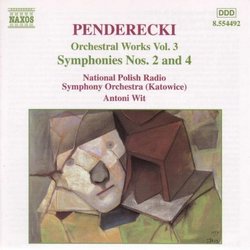| All Artists: Krzysztof Penderecki, Antoni Wit, The National Polish Symphony Orchestra in Katowice Title: Penderecki: Orchestral Works, Vol. 03 Members Wishing: 0 Total Copies: 0 Label: Naxos Release Date: 3/14/2000 Genre: Classical Styles: Historical Periods, Modern, 20th, & 21st Century, Symphonies Number of Discs: 1 SwapaCD Credits: 1 UPC: 636943449226 |
Search - Krzysztof Penderecki, Antoni Wit, The National Polish Symphony Orchestra in Katowice :: Penderecki: Orchestral Works, Vol. 03
 | Krzysztof Penderecki, Antoni Wit, The National Polish Symphony Orchestra in Katowice Penderecki: Orchestral Works, Vol. 03 Genre: Classical
|
Larger Image |
CD DetailsSimilar CDs
|
CD ReviewsLyrical, somewhat brooding, yet approachable pieces Mike Willis | Trafalgar, Victoria Australia | 07/06/2000 (4 out of 5 stars) "Penderecki's music used to be something of a party piece in our house - I could clear a room (of people) simply by putting on an old Muza LP of The Nature of Sonority number two - one of those noisy, loud and dare I say somewhat wonderful pieces from the 1960s, complete with (I joke not) a part for vacuum cleaner.But have no fear: the two symphonies on this disk are very well behaved yet are very much the work of this composer in his later style featuring a traditional orchestra, playing rich melodies composed for a large and often string based orchestra. Still, this is still very much the work of Penderecki - there is a typical and somewhat gloomy style to his work which can be heard in these two symphonies and which can also be heard in more exotic earlier works - yet they are basically, very enjoyable, tuneful and thoroughly approachable works. Oddly enough when the second symphony was first recorded, some years ago, it was slated by critics who felt that Penderecki had abandoned the radical style so common in the 1960s and returned to romanticism. Superficially, this might seem to be the case, but in hindsight, these symphonies seem like a logical extension of earlier work - almost a maturing of the earlier style into something less hectoring and designed to shock. Even more, they now seem to be a bridge between the radicalism of the 1960s and the new romanticism of composers such as Part. If you like Britten, Shostakovich, Bartok you will find these two symphonies well worth the money. If you are a fan of the work of Part you will find some similarities in these two symphonies. The performances are very fine (amongst Wit's best work) and the sound is excellent, detailed and rich - words which might describe the works themselves. Once you have collected this disk go for the rest of the series, and try to obtain the superb violin concerto, once available on Sony with Stern as the violinist" The dark, brooding Neo-Romantic JohnWYC | Hong Kong | 05/26/2007 (5 out of 5 stars) "Penderecki, who was viewed as a god in avant-garde circles, shocked them utterly with his St. Luke Passion, employing traditional forms and harmonies (yes, even minor and major chords). Obviously, he went backwards further, as if searching for his roots, in his Symphony No. 2, his most romantic/traditional work. Penderecki's symphonies all display the common trait of despair, dark undercurrents, and unresolved sombreness that would have made Shostakovich cry. Indeed, the codas are always resigned, never victorious. His music is not about happiness and the joys of life, but more about fate and the horrors of death. His music also contains threads of Shostakovich irony in the fast passages, combined with his trademark of using descending chromatic scales in the melodies, as if falling into doom. (The tragic history of 20th century Poland must have had a strong influence on Penderecki's music). Symphony No. 2, with its recurrent quote of Silent Night (the symphony is subtitled 'Christmas'), is relatively more wistful than the other symphonies, but still, the sense of tragedy is to be found everywhere in the work. I especially admire Penderecki's masterful use of the sonata form (both symphonies are in one movement). Climaxes build up surely and inevitably, and satisfaction is always rewarded, especially the tragic march, replete with howling horns and tolling bells, rooted in traditional harmonies. The heart of the work is of course the haunting adagio in the middle. Symphony No. 4, subtitled 'Adagio', is a slightly more rigorous work, opening with grim calls from trumpets and poundings from lower strings. It is not that slow, as the title suggests, but the symphony does contain slow, introspective quasi-cadenzas for different instruments. There is an interesting use of roto-toms in the latter part of the work (also used in the fiery Symphony No. 3). Again, the symphony ends fatefully. Wit and his Polish orchestra play with much power and feeling. The sound is more than good. For those who want to investigate Penderecki's mature neo-Romantic style, Symphony No. 2 would be the first place to start with. Penderecki is especially recommended for all lovers of Shostakovich." A Good Introduction to Penderecki Karl W. Nehring | Ostrander, OH USA | 08/03/2009 (4 out of 5 stars) "Penderecki first started composing his Symphony No. 2 on Christmas Eve, 1979, and the work has been subtitled Christmas Symphony. It contains musical allusions to the hymn, Silent Night, but would certainly not be taken by most listeners as "Christmas music." Of Penderecki's symphonies, this one is the most easily accessible for most listeners, making this disk a good starter disk for those classical music fans who would like to take a chance on some fairly contemporary symphonic music. Those who are comfortable with the symphonies of Shostakovitch, for example, should feel comfortable with the Penderecki Second, although the two composers sound quite a bit different. The overall mood of the Second is dark and somber, but there is an undercurrent of hope, a glimmer of light, but no neat, happy ending.
The Fourth, completed about a decade later, is more complex in its construction and mood, ranging from loud and boisterous to introspective, almost chamber-music passages. If you squint your musical eyes, you might swear that you behold the ghost of Mahler hovering above the orchestra, but as you look closer, you see that the apparition is smiling, making you wonder if that could really be the Mahler you have read about, and then you realize that the music has made you smile, too. The orchestra plays well, the sound quality is excellent, and at the Naxos price, this disk represents an easily affordable way for listeners to experience music they might be afraid to take a chance on at major-label prices. Of the three volumes of Penderecki's orchestral music currently available on Naxos, this one is probably the best one with which to start your exploration of Penderecki's musical universe. What are you waiting for?" |

 Track Listings (10) - Disc #1
Track Listings (10) - Disc #1
